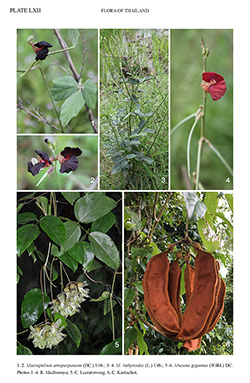e-Flora of Thailand
Volume 4 > Part 3.3 > Year 2023 > Page 619 > Leguminosae-Papilionoideae > Mucuna
3. Mucuna gigantea (Willd.) DC.wfo-0000182437
Prodr. 2: 405. 1825; Baker in Hook.f., Fl. Brit. India 2(4): 186. 1876; Kurz, Contrib. Burm. Fl. 3: 245. 1876; Prain, J. Asiat. Soc. Bengal, Pt. 2, Nat. Hist. 66(1): 68. 1897 & 66(2): 408. 1897; Gagnep. in Lecomte, Fl. Indo-Chine. 2(3): 318. 1916; Ridl., Fl. Malay Penins. 1: 577. 1922; Merr., Enum. Philipp. Fl. Pl. 2: 308. 1923; Craib, Fl. Siam 1(3): 443. 1928; Backer & Bakh.f., Fl. Java 1: 630. 1963; T.C.Huang & H.Ohashi in H.L.Li et al., Fl. Taiwan 3: 342. 1977; Thuân in Aubrév. & J.-F.Leroy, Fl. Cambodge, Laos & Vietnam 17: 35, pl. 3, f. 11–12. 1979; Tateishi & H.Ohashi, Bot. Mag. Tokyo 94: 92. 1981; Wilmot-Dear, Kew Bull. 39(1): 56. 1984; 42(1): 38. 1987; 45(1): 5. 1990; 46(2): 217. 1991; 47(2): 213. 1992 & Thai Forest Bull., Bot. 36: 121. 2008; P.H.Hô, Câyco Việtnam 1(2): 1185. 1991; Rudd in Dassanayake & Fosberg, Handb. Fl. Ceylon 7: 260. 1991; R.Sha & Wilmot-Dear in C.Y.Wu et al., Fl. China 10: 213. 2010; Wiriad. et al., Blumea 61(2): 108. 2016.— Dolichos giganteus Willd., Sp. Pl., ed. 4, 3(2): 1041. 1802. Plate LXII: 5–6.
Accepted Name : This is currently accepted.
Description : Woody climbers; stems glabrous or sparsely pubescent. Stipules lanceolate, 3–4 mm long, caducous. Leaves: petioles 4.5–9.5 cm long, sparsely pubescent; rachis 1.5–3 cm long; stipels apicular, 2–4 mm long, persistent; petiolules 3–7 mm long, pubescent. Leaflets: both surfaces sparsely pubescent; lateral veins 4–5 pairs, not ending into the margin; terminal leaflet elliptic or ovate-elliptic, apex acuminate, base obtuse, margin entire, 10–11.5 by 4–5.5 cm; lateral leaflets ovate, apex acuminate, base cordate, margin entire, 7–10.5 by 4–6 cm. Inflorescences axillary, arranged in corymbose pseudoraceme, 8–21 cm long; peduncles 4–8(–15) cm long; bracts ovate to elliptic, 3–5 mm long, caducous; sterile bracts absent; bracteoles ovate-lanceolate, 16–18 mm long, caducous. Flowers 3–4 cm long; pedicels 15–20 mm long, densely pubescent. Calyx 5-lobed, 10–12 mm long, outside with silver hairs and irritant bristles; tube 6–9 mm long; lobes obtuse-acute, 1–3 mm long. Corolla pale green or greenish white; standard ovate-elliptic, 2–3 by 1.5–2.5 cm, apex obtuse or emarginate, base cordate, margin entire with brown hairs at base, middle part without irritant bristles, claw 3–4 mm long; wings elliptic-oblong, 3–4.5 cm long, apex obtuse, base cordate or sagittate, margin entire with brown hairs at base, claw 4–6 mm long; keel 3–4 cm long, apex acuminate-obtuse, base sagittate, margin entire with brown hairs at base, claw 8–12 mm long. Stamens 3–4 cm long; vexillary stamen 2.5–3 cm long; staminal tube 2–2.5 cm long, glabrous; basifixed anthers glabrous; versatile anthers bearded. Ovary straight, sessile, 4–5 mm long, densely pubescent, 4-ovuled; style 2.5–3 cm long, scattered pubescent; stigma capitate, ca 1 mm in diameter, bearded. Pods leathery, oblong or elliptic-oblong, compressed, 12–15.5 by 5–6 cm, with irritant bristles; marginal wings present, 8–15 mm wide; lamellae absent; endocarp septate. Seeds (1–)3(–4), circular-elliptic, compressed, 2–3 by 1.5–2.5 cm, slightly rough, dull black or dark brown, with streaked mottling; hilum 4.5–6 cm long, circling at least or more than 50% of the seed circumference; aril absent.
Thailand : CENTRAL: Krung Thep Maha Nakhon (Bangkok), Samut Songkhram (Amphawa); PENINSULAR: Ranong (Kra Buri), Chumphon (Pathio), Ranong, Phangnga, Nakhon Sri Thammarat (Khanom), Trang (Tarutao, Ko Kradan, Ko Sukon), Songkhla (Chana, Hat Yai, Sathing Phra, Thepha).
Distribution : Africa, India (type), Sri Lanka, Myanmar, Japan, Taiwan, Vietnam, Peninsular Malaysia (Lankawi, Malacca, Perak), Singapore, the Philippines, Australia.
Ecology : Evergreen forest, littoral forest, seaside-mangrove vegetation, open swampy scrub; 0–150 m alt. Flowering: April–December; fruiting: May–December.
Vernacular : Krachiap (กระเจี๊ยบ); ma mui (หมามุ่ย)(Bangkok); ma mui chang (หมามุ่ยช้าง); ba ling (บ้าลิง)(Phangnga); saba ling lai (สะบ้าลิงลาย)(Central).

